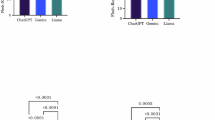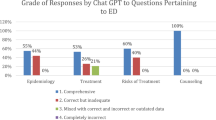Abstract
This study aimed to evaluate the reliability, readability, and understandability of chatbot responses to frequently asked questions about premature ejaculation, and to assess the contributions, potential risks, and limitations of artificial intelligence. Fifteen questions were selected using data from Google Trends and posed to the chatbots Copilot, Gemini, ChatGPT4o, ChatGPT4oPlus, and DeepSeek-R1. Reliability was evaluated using the Global Quality Scale(GQS) by two experts, readability was assessed with the Flesch Kincaid Reading Ease(FKRE), Flesch Kincaid Grade Level(FKGL), Gunning Fog Index(GFI), and Simple Measure of Gobbledygook(SMOG), and understandability was evaluated using the Patient Educational Materials Assessment Tool for Printable Materials(PEMAT-P). Additionally, the consistency of source citations was examined. The GQS were as follows: Copilot: 3.96 ± 0.66, Gemini: 3.66 ± 0.78, ChatGPT4o: 4.83 ± 0.23, ChatGPT4oPlus: 4.83 ± 0.29, DeepSeek-R1:4.86 ± 0.22 (p < 0.001). The PEMAT-P were as follows: Copilot: 0.70 ± 0.05, Gemini: 0.72 ± 0.04, ChatGPT4o: 0.83 ± 0.03, ChatGPT4oPlus: 0.77 ± 0.06, DeepSeek-R1:0.79 ± 0.06 (p < 0.001). While ChatGPT4oPlus and DeepSeek-R1 scored higher for reliability and understandability, all chatbots performed at an acceptable level (≥70%). However, readability scores were above the recommended level for the target audience. Instances of low reliability or unverified sources were noted, with no significant differences between the chatbots. Chatbots provide highly reliable and informative responses regarding premature ejaculation; however, it is evident that there are significant limitations that require improvement, particularly concerning readability and the reliability of sources.
This is a preview of subscription content, access via your institution
Access options
Subscribe to this journal
Receive 12 print issues and online access
$259.00 per year
only $21.58 per issue
Buy this article
- Purchase on SpringerLink
- Instant access to full article PDF
Prices may be subject to local taxes which are calculated during checkout
Similar content being viewed by others
Data availability
All data generated or analysed during this study are included in this published article [and its supplementary information files]. We confirm that any accession codes or datasets mentioned in the article will be made publicly available shortly after proof submission and that database records will be updated with publication details once available.
References
Porst H, Montorsi F, Rosen RC, Gaynor L, Grupe S, Alexander J. The premature ejaculation prevalence and attitudes (PEPA) survey: prevalence, comorbidities, and professional help-seeking. Eur Urol. 2007;51:816–23. https://doi.org/10.1016/j.eururo.2006.07.004
Saitz TR, Serefoglu EC. The epidemiology of premature ejaculation. Transl Androl Urol. 2016;5:409–15. https://doi.org/10.21037/tau.2016.05.11
Athanasiadis L. Premature ejaculation: is it a biogenic or a psychogenic disorder? Sex Marital Ther. 1998;13:241–55. https://doi.org/10.1080/02674659808406567
Althof S. Prevalence, characteristics and implications of premature ejaculation/rapid ejaculation. J Urol. 2006;175:842–8. https://doi.org/10.1016/S0022-5347(05)00341-1
Martin C, Nolen H, Podolnick J, Wang R. Current and emerging therapies in premature ejaculation: where we are coming from, where we are going. Int J Urol. 2017;24:40–50. https://doi.org/10.1111/iju.13202
Shechter A, Gruenwald I. New technologies developed for treatment of premature ejaculation. Int J Impot Res. 2024 Nov;36:700–5. https://doi.org/10.1038/s41443-024-00875-w
Hall AK, Bernhardt JM, Dodd V, Vollrath MW. The digital health divide: evaluating online health information access and use among older adults. Health Educ Behav. 2015;42:202–9. https://doi.org/10.1177/1090198114547815
Papaharitou S, Athanasiadis L, Nakopoulou E, Kirana P, Portseli A, Iraklidou M, et al. Erectile dysfunction and premature ejaculation are the most frequently self-reported sexual concerns: profiles of 9536 men calling a helpline. Eur Urol. 2006;49:557–63. https://doi.org/10.1016/j.eururo.2005.09.023
Al Sliman R, Kuru TH, Struck JP, Heinrichs AL, Arndt K, Salem J, et al. Usage of the internet and digital health among urological patients: findings from a Cross-Sectional study. Urol Int. 2025:1-7. https://doi.org/10.1159/000544873
Şahin MF, Keleş A, Özcan R, Doğan Ç, Topkaç EC, Akgül M, et al. Evaluation of information accuracy and clarity: ChatGPT responses to the most frequently asked questions about premature ejaculation. Sex Med. 2024;12:qfae036. https://doi.org/10.1093/sexmed/qfae036
Bernard A, Langille M, Hughes S, Rose C, Leddin D, Veldhuyzen van Zanten S. A systematic review of patient inflammatory bowel disease information resources on the World Wide Web. Am J Gastroenterol. 2007;102:2070–7. https://doi.org/10.1111/j.1572-0241.2007.01325.x
Kincaid JP, Fishburne RP, Rogers RL, Chissom BS Derivation of new readability formulas (automated readability index, fog count and flesch reading ease formula) for navy enlisted personnel. University of Central Florida; 1975, Report No.: Institute for Simulation and Training; 56. https://doi.org/10.21236/ADA006655
Gunning R The Technique of Clear Writing. New York: McGraw-Hill; 1952.
Mc Laughlin GH. SMOG grading-a new readability formula. J Read. 1969;12:639–46.
Shoemaker SJ, Wolf MS, Brach C. Development of the Patient Education Materials Assessment Tool (PEMAT): a new measure of understandability and actionability for print and audiovisual patient information. Patient Educ Couns. 2014;96:395–403. https://doi.org/10.1016/j.pec.2014.05.027
Wang H, Fu T, Du Y, Gao W, Huang K, Liu Z, et al. Scientific discovery in the age of artificial intelligence. Nature. 2023;620:47–60. https://doi.org/10.1038/s41586-023-06221-2
Haug CJ, Drazen JM. Artificial intelligence and machine learning in clinical medicine, 2023. N Engl J Med. 2023;388:1201–8. https://doi.org/10.1056/NEJMra2302038
Baturu M, Solakhan M, Kazaz TG, Bayrak O. Frequently asked questions on erectile dysfunction: evaluating artificial intelligence answers with expert mentorship. Int J Impot Res. 2025;37:310–4. https://doi.org/10.1038/s41443-024-00898-3
Nashed JY, Liblik K, Dergham A, Witherspoon L, Flannigan R. Artificial intelligence in andrology: a new frontier in male infertility diagnosis and treatment. Curr Urol Rep. 2025;26:29. https://doi.org/10.1007/s11934-025-01257-5
Xiong Y, Zhang Y, Zhang F, Wu C, Qin F, Yuan J. Applications of artificial intelligence in the diagnosis and prediction of erectile dysfunction: a narrative review. Int J Impot Res. 2023;35:95–102. https://doi.org/10.1038/s41443-022-00528-w
Warren CJ, Edmonds VS, Payne NG, Voletti S, Wu SY, Colquitt J, et al. Prompt matters: evaluation of large language model chatbot responses related to Peyronie’s disease. Sex Med. 2024;12:qfae055. https://doi.org/10.1093/sexmed/qfae055
Author information
Authors and Affiliations
Contributions
SG, SK, MG, AHK, MO, MGK, SS, SY, BA: Designing, drafting, revising, providing study conception, data acquisition, analysis, and interpretation. All authors approved the final version of the manuscript to be published.
Corresponding author
Ethics declarations
Competing interests
The authors declare no competing interests.
Ethical approval
As the artificial intelligence chatbots utilized in this study are publicly accessible, and the study did not involve human or animal participants, ethical approval was not required.
Additional information
Publisher’s note Springer Nature remains neutral with regard to jurisdictional claims in published maps and institutional affiliations.
Rights and permissions
Springer Nature or its licensor (e.g. a society or other partner) holds exclusive rights to this article under a publishing agreement with the author(s) or other rightsholder(s); author self-archiving of the accepted manuscript version of this article is solely governed by the terms of such publishing agreement and applicable law.
About this article
Cite this article
Gonultas, S., Kardas, S., Gelmis, M. et al. Chatbots’ performance in premature ejaculation questions: a comparative analysis of reliability, readability, and understandability. Int J Impot Res (2025). https://doi.org/10.1038/s41443-025-01179-3
Received:
Revised:
Accepted:
Published:
DOI: https://doi.org/10.1038/s41443-025-01179-3



